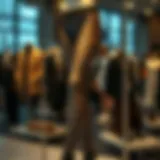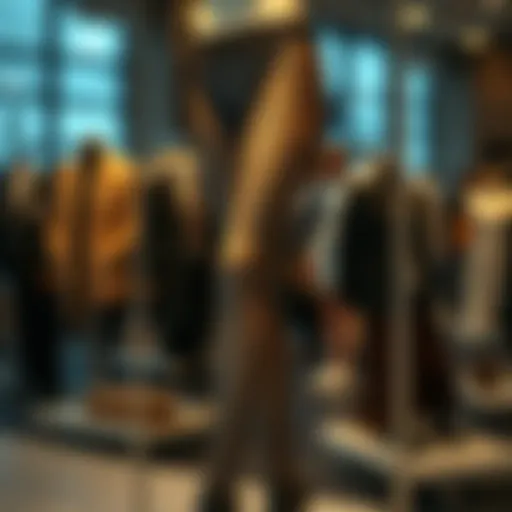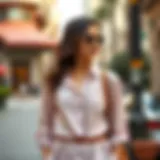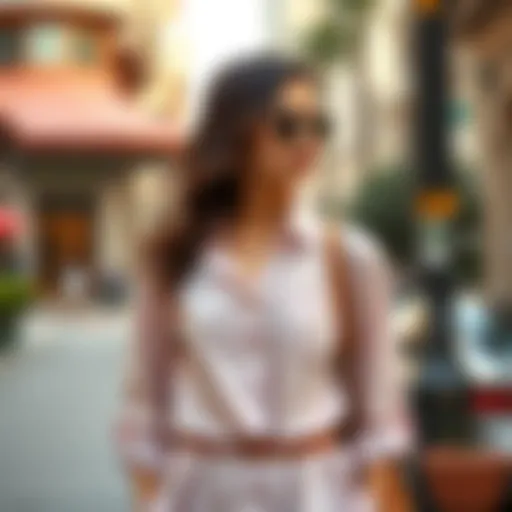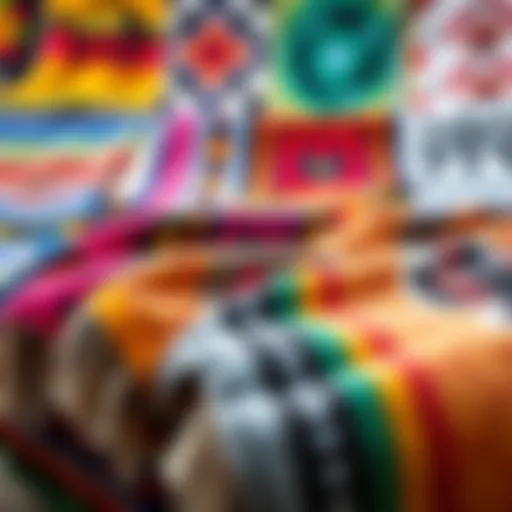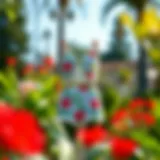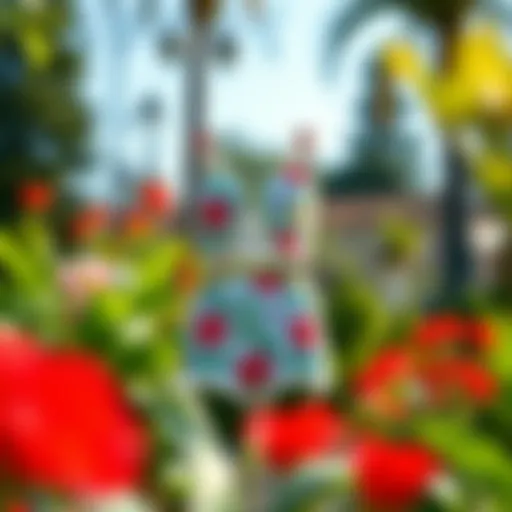The Appeal of Non-Prescription Fashion Glasses
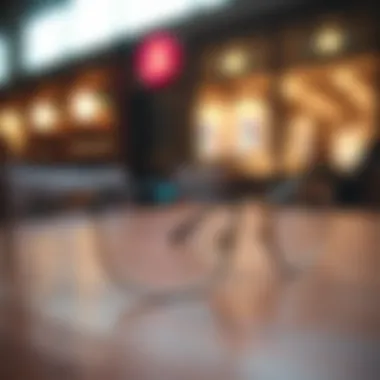
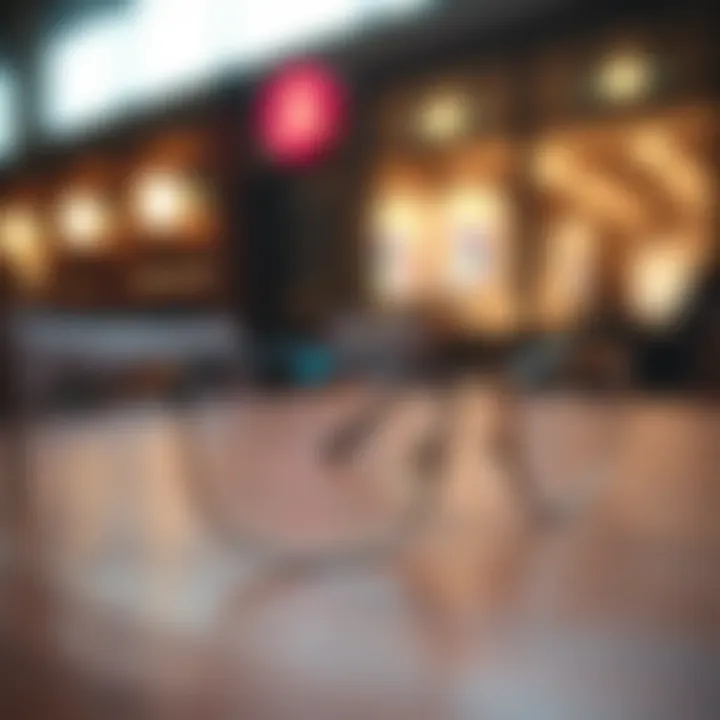
Intro
The realm of fashion has undergone a sea change, with non-prescription fashion glasses stepping into the limelight. Increasingly, these eyewear items serve as not just a practical accessory but as essential components of personal style. Gone are the days when glasses were merely a tool for vision correction. Today, they stand as distinct statements reflecting individuality and aesthetic preferences. For many, selecting the right pair of glasses is akin to choosing a signature accessory; it can make or break an outfit.
In a world obsessed with personal branding and visual appeal, non-prescription glasses offer a unique canvas for self-expression. They come in myriad styles and materials, catering to diverse tastes. From retro-inspired frames to sleek, modern designs, the options can be overwhelming—but therein lies the allure. Understanding how to navigate this exciting landscape can transform the mundane into the extraordinary.
Fashion Trends
Non-prescription fashion glasses are more than just trendy; they're a cultural phenomenon that encapsulates the essence of current fashion trends. In part, their popularity correlates with broader societal movements that emphasize self-expression, creativity, and individuality.
Current Seasonal Trends
In recent seasons, oversized frames have dominated the fashion scene. Think bold, chunky designs that exude confidence and personality. These glasses not only add drama to your look but also provide versatility, seamlessly transitioning from casual outings to formal events. Additionally, clear frames remain a favorite for those looking for a minimalist aesthetic—effortlessly stylish without overshadowing other outfit components.
The color palette is equally intriguing. Earthy tones, such as olive green and terracotta, have made a comeback, echoing the growing interest in natural and organic aesthetics. On the flip side, vivid colors like electric blue and deep red offer a playful twist, allowing wearers to showcase their flamboyant side.
Influential Style Icons
When discussing influential style icons, two names stand out: Iris Apfel and Harry Styles. Iris, known for her oversized frames and eclectic fashion sense, embodies the idea that glasses can be an extension of one's personality. Meanwhile, Harry has showcased a range of non-traditional eyewear, from flamboyant cat-eyes to bold squares, pushing the envelope on gender norms in fashion.
"Your glasses should say something about you. They don’t just sit on your nose—they tell the world who you are."
Sustainable Practices
The popularity of non-prescription fashion glasses has also sparked a conversation around sustainability in fashion. As consumers become more eco-conscious, the demand for ethical and sustainable practices in eyewear has surged. Many brands now offer frames made from recycled materials, giving a new twist to the phrase "reduce, reuse, recycle."
Eco-friendly Fabrics
Leading the charge are companies like Warby Parker and ECW, who have committed themselves to sourcing eco-friendly materials. These frames often feature bio-acetate, a biodegradable plastic that adds a layer of responsibility to your fashion choices. Not only do they look good, but they also contribute to a decline in environmental impact—perfect for the style-savvy and eco-conscious wearer alike.
Ethical Fashion Brands
In addition to material considerations, choosing brands with ethical practices is vital. Companies like Lisa Says Gah! and Modo are known for their commitment to fair labor practices and transparent supply chains. Supporting such brands ensures that your choices leave a positive mark not just on your wardrobe but also on the world.
Prologue to Non-Prescription Fashion Glasses
The world of fashion eyewear has blossomed into a vital accessory for personal expression and aesthetic appeal. Non-prescription fashion glasses, once relegated to the followers of a particular trend, have evolved into a staple within contemporary wardrobes. Understanding their significance is essential not only for fashion enthusiasts but also for designers and everyday consumers alike.
Definition and Overview
Non-prescription fashion glasses refer to eyewear without corrective lenses designed purely for styling rather than vision correction. These eyewear pieces serve various purposes—from adding flair to a mundane outfit to making a bold statement in a fashionable ensemble. Typically, they are affordable and easily accessible, allowing individuals of varying tastes and financial backgrounds to utilize them without needing an eye exam or prescription.
The appeal lies not solely in aesthetics but also in the subtle functions these glasses provide, such as UV protection and an excellent way to frame one's face. The market has witnessed a staggering growth in these accessories, especially as brands, both established and emerging, flood the market with unique designs. According to recent trends, fashion glasses can serve to amplify one’s personality, acting as an accessory to enhance not just looks but also confidence.
The Rise of Eyewear as Fashion Statement
In today’s society, eyewear is no longer confined to functionality. It has transcended into a powerful fashion statement. The rise of social media influencers has significantly contributed to this shift, showcasing how eyewear can complement various styles and trends. Instagram feeds are adorned with images of influencers donning oversized frames or retro styles, urging followers to adopt these visually striking accessories.
Moreover, the cultural landscape has shifted to embrace glasses as a symbol of intelligence and sophistication. They’re viewed as an essential part of an individual’s signature look, transitioning from mere tools for eyesight improvement to mainstays of personal branding.
"Eyewear has become more than just a tool; it's a canvas for self-expression and individuality."
As styles continue to evolve, the boundaries of what constitutes fashionable eyewear are constantly pushed, with non-prescription glasses leading the charge. Makers are utilizing bold colors, unique shapes, and materials that reflect current trends, catering to a populace that values individuality in a world of mass production.
Historical Context
Understanding the historical context of non-prescription fashion glasses is fundamental for appreciating their current allure and significance in contemporary society. Throughout the ages, eyewear has morphologically evolved not just as a tool for vision correction but as a powerful emblem of style and culture. By examining how the perceptions of eyeglasses have shifted over time, we can see how these accessories have transcended their utilitarian origins to become integral to fashion.
Eyewear Through the Ages
From ancient times to the present day, eyewear has played a complex role in society. In early civilizations, such as ancient Egypt and Rome, glasses were not widely understood. The use of polished crystals and other rudimentary optical tools reflected an intimate relationship with sight and the desire for aesthetic beauty. By the 13th century, the development of bifocals by notable figures such as Roger Bacon marked a pivotal point in the history of eyewear.
As we moved into the 18th and 19th centuries, eyeglasses became styled with various materials. The introduction of spectacles with ornate detailing or gold plating started to convey wealth and status. Wealthy individuals frequently used frames as a display of opulence. Eyewear became not only functional but also a fashion accessory that denoted social class and included intricate details like filigree designs or gemstone embellishments.
In modern history, particularly the 20th century, eyewear underwent a revolution. The emergence of fashion-forward designers and brands such as Ray-Ban and Persol reshaped the narrative. Eyewear was no longer merely a tool for medical necessity; it became an extension of personality and personal style. Cat-eye frames, oversized sunglasses, and bold colors all transformed spectacles into an artistic expression, its allure tying directly into pop culture and celebrity endorsements, making them highly sought-after items.
Today, non-prescription fashion glasses symbolize individuality, self-expression, and creativity. Many fashion enthusiasts now don these frames without any functional lens, embracing them as a statement piece. The notion that one can wear glasses for style means that the historical burden of corrective lenses has largely dissipated, allowing individuality to shine through. Thus, tracing this arc from utility to vanity offers insights into modern consumer trends and societal attitudes toward eyewear.
Cultural Influences on Eyewear Fashion
Cultural shifts have substantially influenced the evolution of eyewear in fashion circles. The portrayal of eyewear in cinema and literature has shaped public perception. For instance, iconic characters from films like Breakfast at Tiffany's or Harry Potter turned glasses into not just necessity but a core aspect of their persona. This cultural representation often trickles down into mainstream fashion, playing a role in what's considered stylish at any given time.
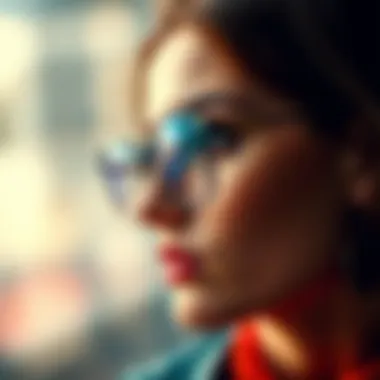
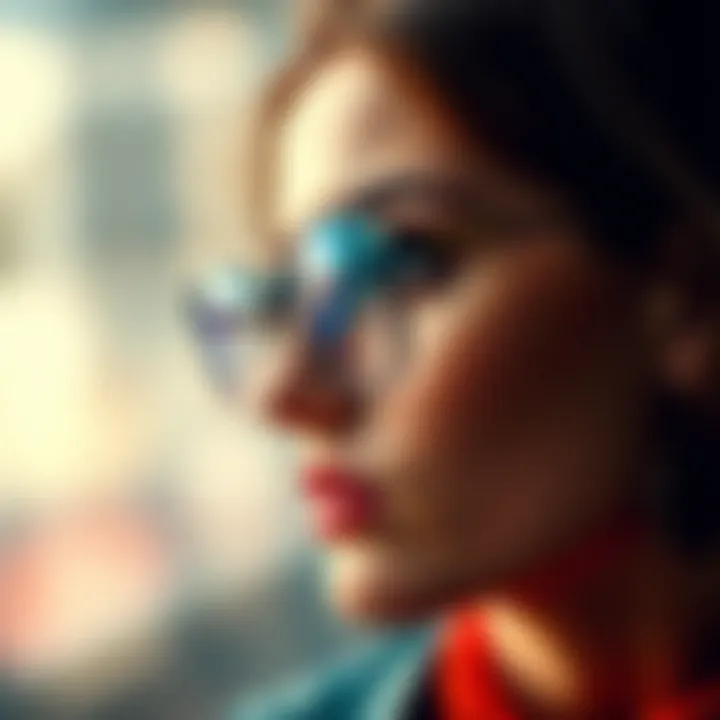
Additionally, the rise of social media has made these cultural influences even more pronounced. Platforms like Instagram and TikTok serve as launching pads for eyewear trends, where influencers showcase unique styles, encouraging followers to hop on the bandwagon. This zeitgeist creates a fertile environment for non-prescription glasses to flourish, helping them become essential items that not only enhance personal style but also speak volumes about identity and trends.
Eyewear is now seen as art, with many designers collaborating with artists to create exclusive pieces that challenge conventional designs. This blending of culture, art, and fashion signals a transition wherein non-prescription glasses have become integral in elevating one's wardrobe and reflecting an individual's ethos. In summary, the historical and cultural tapestry surrounding non-prescription fashion glasses showcases their evolution into a multifaceted emblem of personal expression.
Variety of Styles
The myriad styles available in non-prescription fashion glasses play a pivotal role in how wearers express their personality and enhance their overall appearance. This variety is not merely an accessory for vision correction but a substantial part of a person's fashion identity. With a range spanning from timeless classics to avant-garde designs, each style offers something distinct.
Classic Designs
Classic designs have stood the test of time due to their universal appeal and versatility. Styles such as the Aviators, Wayfarers, and Cat Eye frames often invoke nostalgia, while still being trendy. These frames can effortlessly transition from professional settings to casual outings.
- Aviators: Originally designed for pilots, these glasses convey a sense of adventure and ruggedness. They work well on various face shapes, making them an inclusively fashionable choice.
- Wayfarers: Known for their straightforward design, Wayfarers can complement almost any outfit, from a suit to casual jeans, ensuring they remain a staple in many wardrobes.
- Cat Eye Frames: Their vintage flair adds a hint of sophistication and femininity, making them popular among those who favor a classic yet chic look.
The enduring charm of these designs lies in their ability to pair well with numerous styles, making them not just accessories, but also a statement of reliable taste.
Contemporary Trends
In contrast to classical frames, contemporary trends showcase an eclectic mix of materials, shapes, and colors which define modern eyewear fashion. Current trends feature bold colors, oversized frames, and geometric designs. Here’s how they stand out:
- Oversized Frames: These frames ooze confidence, often used as a statement piece in any ensemble. They can range from bold block patterns to translucent pastels, providing ample options for various aesthetics.
- Transparent Frames: The rise of transparent or translucent glasses speaks to the desire for minimalist and understated components in fashion. These frames, often paired with varying colored lenses, add a subtle elegance to any look.
- Geometric Shapes: Hexagonal or octagonal frames push fashion boundaries. They cater to those who want to break away from traditional styles, giving an edgy vibe to conventional attire.
With trends flowing from street style to runways, it’s evident that modern eyewear embraces creativity while pushing practical boundaries.
Unique and Artistic Frames
For individuals seeking something beyond the conventional, unique and artistic frames present endless possibilities. This category often features elaborate designs that can serve as wearable art.
- Handcrafted Styles: Some brands produce limited edition pieces made by skilled artisans. Such frames not only tell a story but also create a personal connection with the wearer.
- Customized Glasses: The ability to personalize frames, selecting from various colors, shapes, and materials allows wearers to truly embody their personal style.
- Themed Frames: From vintage to futuristic motifs, many brands introduce collections inspired by art movements or cultural influences, appealing to those who wish to express their niche interests or passions.
Overall, these unique designs allow individuals to convey a myriad of messages through their eyewear choices, making each pair a unique extension of themselves.
"Style is a way to say who you are without having to speak." – Rachel Zoe.
The assortment of styles in non-prescription fashion glasses not only enhances fashion sense but also empowers individuals to showcase their distinct personalities. As fashion continues to evolve, so does the eyewear landscape, promising an exciting future in styles yet to come.
Materials Used
When it comes to non-prescription fashion glasses, the choice of materials plays a vital role in both aesthetics and functionality. The right material not only affects the look and feel of the eyewear but also influences durability, comfort, and even sustainability. As fashion enthusiasts are becoming more discerning about the products they choose, understanding the characteristics and benefits of various materials has become increasingly essential.
Plastic vs. Metal Frames
Plastic frames are often lauded for their lightweight nature, making them comfortable for all-day wear. They come in a wide array of colors and styles, which means they can be easily tailored to suit personal preferences. However, plastic isn’t without its drawbacks. Over time, exposure to sunlight and wear can lead to fading and cracking, making them less durable than some materials.
On the other hand, metal frames present a classic elegance that appeals to many fashion-conscious consumers. Typically made from materials like stainless steel or titanium, these frames tend to be more robust and can withstand the test of time better than plastic. Their understated sophistication allows them to fit seamlessly into both casual and formal settings. However, metal frames might not be as comfortable for those with sensitive skin, as they can cause irritation in certain cases.
Sustainable Materials
Bamboo Frames
Bamboo frames are becoming increasingly popular in the fashion eyewear market. The use of bamboo, a rapidly renewable resource, is not only eco-friendly but also offers a unique aesthetic appeal. Each pair has its own character, with natural fibers and textures that make them visually striking. Lightweight and comfortable, bamboo frames are perfect for those looking for an ethical choice without compromising on style.
Despite their advantages, bamboo frames do have some limitations. They may not offer the same level of durability as metal options, and their availability can be limited depending on the market. Nevertheless, for environmentally conscious wearers, the appeal of bamboo often outweighs these concerns.
Recycled Plastics
On the other front, recycled plastics have carved their niche in the eyewear industry. Utilizing post-consumer plastic waste not only helps reduce landfill waste but also often requires less energy to produce compared to virgin materials. This material choice reflects a growing trend towards sustainability within fashion, making it an attractive option for those who wish to showcase their commitment to the environment through their accessories.
Recycled plastics come with a certain flexibility, lending themselves to creative designs that can cater to diverse tastes. However, some concerns persist regarding how these materials might hold up over time, specifically in terms of scratch resistance and overall sturdiness. Thus, while they present a great option for eco-minded consumers, one should carefully examine specific products to ensure they meet quality standards.
"Choosing eyewear made of sustainable materials is not just a fashion statement; it’s a lifestyle choice that reflects our values as consumers."
In summary, the material choice in non-prescription fashion glasses not only shapes the practical aspects of eyewear but also highlights personal values, particularly concerning sustainability. It is essential for consumers to be aware of these characteristics, as they’re integral to understanding how non-prescription glasses can complement one's style while resonating with larger ecological concerns.
Functional Aspects
When considering non-prescription fashion glasses, it’s easy to get swept away by their aesthetic appeal. However, functionality plays an equally vital role in their popularity. These glasses offer not just a stylish accessory but also significant benefits that enhance daily life. From safeguarding the eyes against harmful UV rays to mitigating digital eye strain, the functional aspects of these eyewear choices are paramount for both health and style-conscious consumers.
Protection from UV Rays
The sun's rays can be quite unforgiving, making the protection against UV light a top priority when choosing any form of eyewear, including fashion glasses. Non-prescription sunglasses or even clear frames treated with UV-blocking coatings can shield the eyes from potentially damaging ultraviolet radiation.

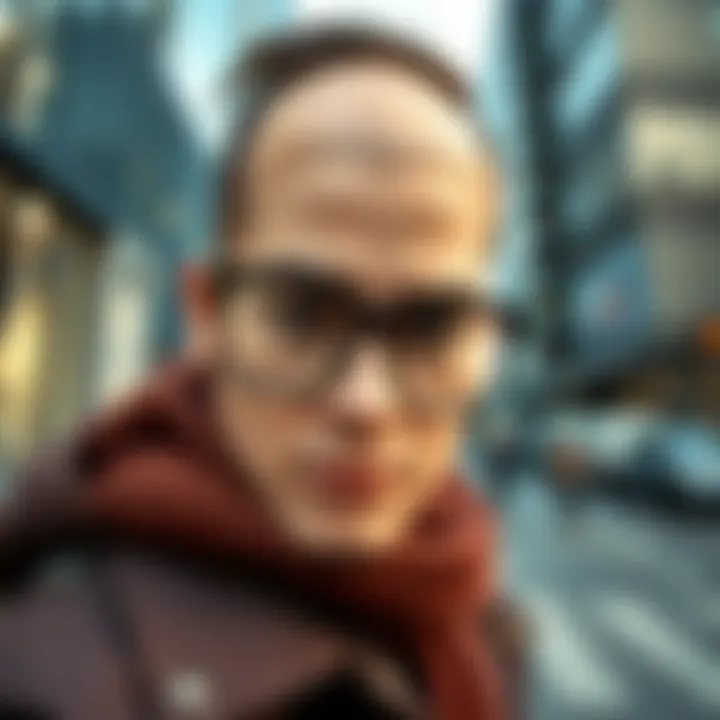
- Why it Matters: Prolonged exposure to UV rays can lead to various eye issues, including cataracts and macular degeneration.
- Key Features: When shopping for fashionable frames, look for those that explicitly mention UV protection, particularly if you plan to wear them outdoors. Many brands produce stylish frames that contain polycarbonate lenses, known for their lightweight and robust nature, while also offering excellent UV shielding capabilities.
- Additional Insights: Wearing glasses with UV protection not only safeguards one's vision but also enhances comfort while outdoors. This can be especially relevant for those who spend time driving, playing sports, or just enjoying a sunny day at the park.
As the saying goes, "better safe than sorry," especially when it comes to our vision.
Blue Light Blocking Lenses
With the rise of screens—be it smartphones, laptops, or televisions—blue light exposure has become a buzzword. Non-prescription fashion glasses with blue light blocking lenses have gained traction recently for their perceived benefits in reducing eye fatigue.
- Understanding Blue Light: Blue light, emitted from digital devices and energy-efficient lighting, is known to disrupt sleep patterns and contribute to digital eye strain. A growing number of individuals now experience discomfort, which can significantly affect daily productivity.
- Fashion Meets Function: Many brands now offer glasses that combine style with functionality. For instance, some trendy frames come equipped with specialized coatings to filter out blue light without losing artistic flair. Choosing spectacles that encompass both conditions allows wearers to remain chic while ensuring comfort during long screen sessions.
- User Appeal: As fashion enthusiasts are increasingly conscious of the impact of technology on their health, eyeglass options that include blue light filtering properties are likely to appeal to a growing demographic. Incorporating these lenses means not just looking good—it's about feeling good too.
"In the digital age, taking care of our eyes is not just smart; it’s essential."
Being discerning about the functional attributes of non-prescription fashion glasses can elevate one’s wardrobe significantly. It’s commendable to embrace style, but pairing it with function ensures that individuals not only look good but also feel their best in today’s fast-paced,screen-centered reality.
The Role of Non-Prescription Glasses in Personal Style
Non-prescription fashion glasses have become a significant accessory in modern wardrobes. With their ability to add an element of sophistication or quirkiness to an outfit, these glasses go beyond functionality. Instead, they serve as a powerful tool for personal expression. By choosing the right style, color, and shape, individuals can convey their personality, mood, or even their current fashion trends without needing corrective lenses. As such, they have transformed from a mere accessory to a statement piece that complements and enhances various looks.
Accessorizing with Eyewear
Eyewear is not just about vision correction anymore. The versatility of non-prescription glasses allows them to be treated like any other accessory. They can complement or contrast with an outfit to create a cohesive look. For instance, pairing oversized frames with a simple outfit can add a layer of drama, while sleek, minimalist designs may offer a more polished appearance.
Here are a few tips for accessory coordination:
- Blend with Outfits: Choose frames that resonate with the color palette of your clothing. Earthy tones in glasses may suit a boho outfit, while bright colored frames can elevate a playful look.
- Layering: Glasses can be layered with other accessories like hats or scarves. This layered styling creates visual interest and depth. For example, sporting a pair of bold cat-eye glasses with a chunky scarf can help unify the layers.
- Seasonal Choices: The material and color of frames can shift with the seasons. Transitioning from turtle-shell frames in fall to vibrant clear frames in spring creates a fresh look year-round.
In essence, eyewear should be seen as a functional and fashionable part of personal style and not merely an afterthought. A carefully chosen pair of glasses can have the same impact as selecting the right shoes or a statement handbag.
Building a Signature Look
Developing a recognizable personal style is akin to building a brand. Non-prescription glasses can serve as a hallmark of one’s identity. Crafting a signature look means selecting frames that not only resonate with one’s individuality but also act as pillars within their overall aesthetic.
To build this signature panache, consider the following:
- Know Your Face Shape: Understanding your face shape can help in selecting frames that work well. For example, round frames for square faces or angular shapes for round faces can highlight features effectively.
- Reflect Your Personality: If you enjoy whimsical fashion, consider colorful, fun frames adorned with unique patterns. For a classic, more serious vibe, you might opt for tortoise-shell or metal frames.
- Consistency is Key: Sometimes it’s about repetition; if you consistently wear a specific style, it becomes part of your identity. This consistency helps establish a recognizable vibe that others can associate with you.
"Eyewear is a reflection of your personality. A well-chosen pair can speak volumes without uttering a word."
Non-prescription glasses are more than an accessory; they play a pivotal role in the fashion narrative of the wearer. With conscious selection and creative styling, they can embody one’s personal brand, making a profound fashion statement that extends beyond their utilitarian purpose.
Consumer Trends and Market Analysis
When discussing non-prescription fashion glasses, it's crucial to understand the current consumer trends and market dynamics that shape this sector. In recent years, these accessories have transitioned from merely utilitarian items to essential fashion statements. This shift highlights the growing recognition of eyewear as a powerful tool of personal expression, influenced by varying elements such as lifestyle changes, aesthetic preferences, and the societal push towards individuality.
The importance of studying consumer trends lies in its ability to reveal what today's market demands are. With an increasing emphasis on unique, customized fashion choices, consumers are looking not just for functional items but also for pieces that resonate with their personal style and values. Non-prescription glasses fill this niche perfectly, offering versatility and creativity without the confines of corrective lenses.
- Market Benefits: The rise of non-prescription glasses keeps brands and retailers on their toes, prompting them to innovate continuously. On this journey, brands must stay attuned to what resonates with their audience—color palettes, frame styles, and even materials.
- Considerations for Consumers: Shoppers are keen to align with brands that offer transparency concerning sourcing and sustainability. Being mindful of where materials come from and their environmental impact is increasingly important for consumers.
Identifying these trends can guide brands in developing products that meet consumer expectations. Those who do this effectively often witness a significant boost in loyalty and brand recognition. Monitoring emerging patterns can provide valuable insights into not only purchase behaviors but also shifts in trend direction over time, ensuring brands remain relevant in an ever-competitive landscape.
Emerging Brands and Innovations
As the eyewear industry thrives, several emerging brands are making a name by focusing on stylish yet accessible non-prescription glasses. Think of established names like Warby Parker, which helped revolutionize the way people perceive purchasing eyewear online. In addition to them, we’re seeing smaller brands tapping into niche markets.
These innovations often manifest through:
- Unique Designs: Many new players are experimenting with unorthodox shapes, bold colors, and mixed materials (think bamboo and metal).
- Customization: Brands like GlassesUSA allow consumers to customize their frame sizes and colors virtually. This tailored approach enhances the shopping experience and empowers consumers to create a look that’s truly theirs.
Ultimately, the whims of fashion are reflective of broader cultural shifts, and new brands emerging in this marketplace are adept at riding the wave of these changes.
The Influence of Social Media
Social media’s role in shaping consumer choices cannot be overstated, especially when it comes to fashion. Platforms like Instagram and TikTok have become platforms for trendsetting, where the next big style can sometimes come from influencers rather than traditional advertising.
- Visual Appeal: The allure of fashion glasses is amplified through visually rich content. Stylish influencers and celebrities sporting unique frames create inspiration that flows through feeds like wildfire. People often aspire to replicate a look they've seen online, making social media a powerful marketing tool.
- User-Generated Content: Consumers are not just passive recipients anymore. Many enjoy showcasing their fashionable choices, with hashtags and challenges encouraging wide sharing. For example, the hashtag #OOTD (Outfit of the Day) can often be seen paired with a fashionable eyewear piece, instantly boosting visibility.
As consumers interact and engage with brands directly through social media, it becomes increasingly vital for eyewear brands to cultivate a positive online presence while also responding to consumer feedback in real-time. This engagement breeds trust and community, often leading to a loyal customer base willing to advocate for the brand.
Emerging trends and insights derived from social media continuously shape the future of non-prescription fashion glasses, affirming their position as a cornerstone of personal expression in the fashion world.
Choosing the Right Pair
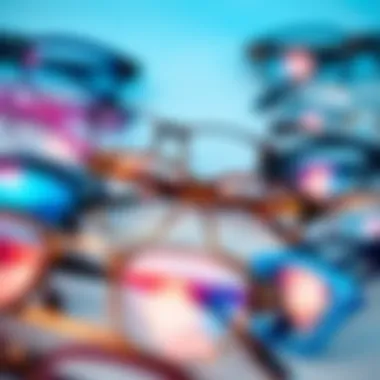
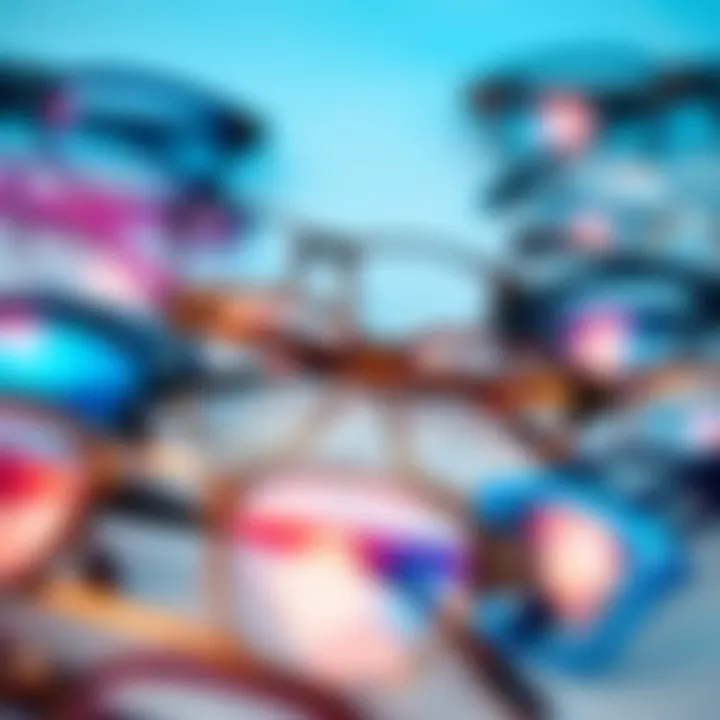
Selecting the right pair of non-prescription fashion glasses is not merely about aesthetics; it involves a mix of personal style, face shape compatibility, and individual color preferences. Each of these elements plays a vital role in how well the glasses integrate into one's overall look. For fashion enthusiasts and designers, this selection process can help in accentuating one's features and expressing a unique identity.
When contemplating the right pair, one must consider the following key aspects:
- Face Shape: Understanding your face shape can guide you in choosing frames that enhance your natural features.
- Color and Style: The hues and shapes of the glasses should resonate with your wardrobe and persona.
This thoughtful approach not only boosts confidence but also ensures that the glasses become a natural extension of who you are.
Identifying Face Shapes
The compatibility of glasses with face shapes cannot be overstated. Each face shape—whether oval, square, round, or heart—brings its own challenges and advantages in terms of selecting eyewear.
- Oval Face: Commonly regarded as the ideal shape, the oval face allows for a wide variety of frame styles, from oversized to angular designs.
- Square Face: Softening the strong jawline is crucial. Consider round or oval frames that provide a contrasting softness.
- Round Face: To elongate the appearance, one might opt for rectangular or wider frames that add definition.
- Heart-Shaped Face: Frames that are wider at the bottom help to balance out the forehead's width, highlighting cheekbones beautifully.
Understanding which category your face fits into will ultimately make the selection process smoother and more impactful. The goal is not just to wear glasses; it's to wear something that harmonizes with your facial structure.
Consideration of Color and Style
Color plays a crucial role in how the glasses will complement the wearer's skin tone, hair color, and overall wardrobe. Neutral colors like black, brown, or tortoiseshell tend to offer versatility and can be paired with nearly any outfit. However, more daring hues may convey particular moods or styles, appealing to those looking to make a bold statement.
When picking out colors, consider these elements:
- Skin Tone: Warm undertones may be uplifted with shades like amber or gold, while cooler undertones could shine with blues and silvers.
- Wardrobe Compatibility: The glasses should match or contrast your wardrobe colors effectively. Look for frames that can add a pop of color to monotone outfits or complement vibrant prints, maintaining a visual balance.
The style of the frames, too, has narrative significance. An avant-garde design can signal a forward-thinking approach to fashion, while classic shapes might represent timeless elegance.
In sum, choosing the right pair of non-prescription fashion glasses involves a keen awareness of face shape, color coordination, and personal style preferences. When done thoughtfully, it leads to a pair of glasses that not only fits well but also resonates deeply with the individual's identity.
Care and Maintenance
Caring for and maintaining non-prescription fashion glasses isn’t just about keeping them clean; it’s about prolonging their lifespan and ensuring they remain a stylish addition to your wardrobe. Just like any other accessory, proper upkeep is key to preserving their aesthetic value and functionality. This section will delve into why care and maintenance are crucial and provide practical advice for the discerning wearer.
Cleaning Techniques
Keeping your fashion glasses clean enhances their visual appeal and ensures you can see clearly through their lenses. Over time, smudges, dust, and scratches can detract from their charm. Here are some simple yet effective cleaning techniques:
- Use a microfiber cloth: Avoid using paper towels or regular cloths. A microfiber cloth is soft and specifically designed to clean lenses without scratching them.
- Lens cleaning solution: Invest in a quality lens cleaner or make a DIY solution by mixing mild dish soap with water. Spray it gently and wipe with the cloth. This can help remove stubborn fingerprints and grime.
- Rinse and wipe: For a quick cleanup, rinse the lenses under lukewarm water to remove loose dirt before polishing. Just don’t forget to dry them off with a microfiber cloth afterwards.
Important Note: Never use ammonia-based cleaners on your lenses, as these can damage the coating.
Future of Non-Prescription Fashion Glasses
As we look to the horizon, the non-prescription fashion glasses segment is shaping up to be a vibrant part of the eyewear landscapes. These accessories are carving their niche, transcending mere functionality. They are quickly becoming an essential ingredient in the recipe of personal expression and style.
What’s most compelling is how technological advancements and rapidly shifting consumer preferences are fostering this growth. By harnessing the latest innovations, brands are likely to deliver products that do more than just adorn the face; they might also integrate functionalities that cater to a tech-savvy audience.
Technological Advancements
We're experiencing a leap in technology that could redefine what we expect from non-prescription glasses. Beyond traditional frames, innovations are likely to include features that blend fashion and function. Imagine glasses that adjust their tint automatically in response to UV rays, or models equipped with smart lenses that track your eye movements for immersive digital experiences.
- Smart Features: Brands like Ray-Ban Stories are already dipping into the waters of smart eyewear, showcasing nifty functionalities like built-in cameras and audio capabilities. This intersection of technology and tradition could potentially elevate non-prescription glasses from mere accessories to multifunctional tools.
- Augmented Reality: The future might also see the incorporation of augmented reality, where users can overlay digital information onto the real world through their glasses. This could lead to a revolution in how individuals interact not just with each other, but also with their environment. Think of the possibilities—a pair of glasses that can highlight points of interest in a city, guiding users through a historical tour.
Such advances not only promise to keep the designs fresh but also ensure that non-prescription glasses remain relevant in a fast-evolving market.
Predicted Trends in the Market
Looking ahead, several trends in the market for non-prescription fashion glasses seem poised to take hold. Based on consumer sentiments and industry trajectories, we can expect a few notable shifts.
- Sustainable Practices: With growing awareness about environmental issues, many brands are leaning toward sustainability. Materials like biodegradable plastics and responsibly sourced wood are likely to feature more prominently. Eco-conscious consumers are looking for products that reflect their values.
- Customization Options: The desire for individuality is pushing brands to offer more customizable eyewear. From selecting lens colors to choosing unique frame shapes, consumers want to make eyewear their own. This trend could not only enhance personal style but also build a stronger brand-consumer relationship.
- Online Shopping Experience: E-commerce continues to dominate, making it easier for consumers to find their ideal pair of glasses without leaving home. Virtual try-on technology is becoming prevalent, allowing customers to see how different styles will look before purchasing.
- Influencer Collaborations and Social Media Effect: Social platforms are buzzing with fashion content, and eyewear is at the forefront. Collaborations between influencers and brands can spark trends almost overnight, making non-prescription glasses a must-have.
- Bamboo Frames: These frames are lightweight and durable while also minimizing environmental impact.
Epilogue
The world of non-prescription fashion glasses serves not just as a style choice, but as a reflection of personal identity. As explored throughout this article, such accessories hold the power to transform an ordinary outfit into a statement of individuality. It's crucial to recognize how these glasses are not merely functional but are integral to personal style and artistic expression.
Summary of Key Points
- Definition and Overview: Non-prescription fashion glasses have emerged as a significant accessory, offering both aesthetic appeal and practical benefits, from UV protection to blue light blocking.
- Historic Influence: The evolution of eyewear has been shaped by cultural trends, adapting to society's shifting views on fashion and identity.
- Diverse Styles: From classic frames to avant-garde designs, there's a plethora of options available, catering to varied tastes and preferences.
- Material Considerations: Sustainability in materials has become paramount, with consumers increasingly aware of eco-friendly choices like bamboo and recycled plastics.
- Consumer Trends: Analyzing market trends and the impact of media on fashion choices reveals a dynamic interplay between brands, influencers, and consumers that reshapes eyewear offerings.
- Care and Maintenance: Proper upkeep of eyewear ensures longevity, underscoring the investment in quality pieces.
Clearly, non-prescription fashion glasses occupy a unique position in both personal expression and cultural discourse.
Final Thoughts on Fashion Glasses
In a society that increasingly values authenticity, non-prescription fashion glasses allow individuals to articulate their sense of style while also addressing functional needs. These accessories serve as a dialogue between the wearer and the world, providing a unique lens through which to view personal aesthetics and communal values. As fashion continues to evolve, the importance of selecting styles that resonate personally will only amplify. Choosing the right pair isn't just about appearance; it's an investment in one's self-image and a testament to one's unique taste.
"Fashion is the armor to survive the reality of everyday life." — Bill Cunningham
For further insights on the intersection of fashion and functionality, consider exploring additional resources such as Fashion Institute of Technology or Vogue's insights on eyewear trends.
Also, communities on platforms like Reddit continue to provide real-time discussions on evolving trends in the eyewear sector.




